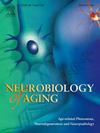Theta-gamma transcranial alternating current stimulation enhances ballistic motor performance in healthy young and older adults
IF 3.5
3区 医学
Q2 GERIATRICS & GERONTOLOGY
引用次数: 0
Abstract
Theta-gamma transcranial alternating current stimulation (TG tACS) over primary motor cortex (M1) can improve ballistic motor performance in young adults, but the effect on older adults is unknown. This study investigated the effects of TG tACS on motor performance and M1 excitability in 18 young and 18 older adults. High-definition TG tACS (6 Hz theta, 75 Hz gamma) or sham tACS was applied over right M1 for 20 min during a ballistic left-thumb abduction motor training task performed in two experimental sessions. Motor performance was quantified as changes in movement acceleration during and up to 60 min after training. Transcranial magnetic stimulation (TMS) was used to assess changes in M1 excitability with motor-evoked potentials (MEP) and short-interval intracortical inhibition (SICI) before and after training. We found that TG tACS increased motor performance compared with sham tACS in young and older adults (P < 0.001), with greater effects for young adults (P = 0.01). The improved motor performance with TG tACS lasted at least 60 min after training in both age groups. Motor training was accompanied by greater MEP amplitudes with TG tACS compared to sham tACS in young and older adults (P < 0.001), but SICI did not vary between tACS sessions (P = 0.40). These findings indicate that TG tACS over M1 improves motor performance and alters training-induced changes in M1 excitability in healthy young and older adults. TG tACS may therefore be beneficial to alleviate motor deficits in the ageing population.
Theta-gamma经颅交流电刺激增强健康年轻人和老年人的弹道运动表现
经过初级运动皮层(M1)的Theta-gamma经颅交流电刺激(TG - tACS)可以改善年轻人的弹道运动表现,但对老年人的影响尚不清楚。本研究考察了TG - tACS对18名青年和18名老年人运动表现和M1兴奋性的影响。高清晰度TG tACS(6 Hz theta, 75 Hz gamma)或假tACS在右侧M1上应用20 分钟,在两个实验阶段进行的弹道左拇指外展运动训练任务中。运动表现被量化为训练期间和训练后60分钟内运动加速度的变化。采用经颅磁刺激(TMS)评价训练前后运动诱发电位(MEP)和短间隔皮质内抑制(SICI)对M1兴奋性的影响。我们发现,与假tACS相比,TG tACS可以提高年轻人和老年人的运动表现(P <; 0.001),对年轻人的影响更大(P = 0.01)。在两个年龄组的训练后,TG - tACS对运动表现的改善持续至少60 min。在年轻人和老年人中,与假tACS相比,运动训练伴TG tACS的MEP振幅更大(P <; 0.001),但SICI在tACS疗程之间没有变化(P = 0.40)。这些发现表明,TG - tACS对M1的作用改善了运动表现,并改变了健康年轻人和老年人训练引起的M1兴奋性变化。因此,TG - tACS可能有助于缓解老年人的运动缺陷。
本文章由计算机程序翻译,如有差异,请以英文原文为准。
求助全文
约1分钟内获得全文
求助全文
来源期刊

Neurobiology of Aging
医学-老年医学
CiteScore
8.40
自引率
2.40%
发文量
225
审稿时长
67 days
期刊介绍:
Neurobiology of Aging publishes the results of studies in behavior, biochemistry, cell biology, endocrinology, molecular biology, morphology, neurology, neuropathology, pharmacology, physiology and protein chemistry in which the primary emphasis involves mechanisms of nervous system changes with age or diseases associated with age. Reviews and primary research articles are included, occasionally accompanied by open peer commentary. Letters to the Editor and brief communications are also acceptable. Brief reports of highly time-sensitive material are usually treated as rapid communications in which case editorial review is completed within six weeks and publication scheduled for the next available issue.
 求助内容:
求助内容: 应助结果提醒方式:
应助结果提醒方式:


